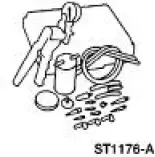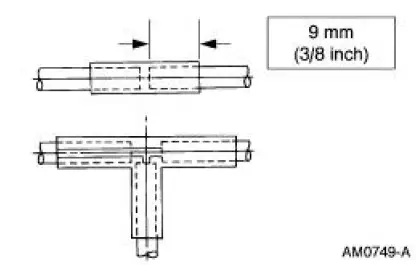Ford Mustang (1999-2004) Service Manual: Vacuum Hose Repair - Mini-Tube
Special Tool(s)
 |
Vacuum Pump Kit 416-D002 (D95L-7559-A) or equivalent |
1. Measure the length of the damaged area of the mini-tube vacuum hose.
2. Cut a piece of standard 1/8 inch inner diameter vacuum hose approximately 25 mm (1 inch longer than the damaged area of the mini-tube vacuum hose).
3. Cut off the mini-tube vacuum hose on each side of the damaged area.
4. WARNING: Read the warning information on the product label to prevent possible personal injury.
Dip the mini-tube hose ends in commercially available paint thinner containing methyl ethyl ketone (MEK). This solvent will seal the mini-tube in the vacuum hose.
5. Insert the ends of the mini-tube vacuum hose approximately 9 mm (3/8 inch) into the ends of the standard 1/8 inch repair vacuum hose section.

6. Shake the repair joint after assembly to make sure the solvent is dispersed and the vacuum line is not plugged.
7. Test the system for a vacuum leak in the repair area.
- Use the Vacuum Tester or equivalent.
 Contaminated Refrigerant Handling
Contaminated Refrigerant Handling
1. CAUTION: If contaminated refrigerant is detected, DO NOT recover the
refrigerant
into your recovery/recycling equipment.
Recover the contaminated refrigerant using suitable recovery-only equipment ...
 Air Distribution and Filtering
Air Distribution and Filtering
Torque Specifications
...
Other materials:
Rear Drive Axle and Differential
The differential housing (4010) consists of a cast aluminum housing and
a cast aluminum
differential housing cover (4033). The differential housing cover uses
silicone sealant as a
gasket.
The hypoid-design gearset consists of a 8.8-inch ...
Installation
1. Install the lower intake manifold gaskets.
2. Connect the fuel charging wiring harness to the rear of the lower intake
manifold and install the
manifold.
3. Install the intake manifold fasteners and tighten in the sequence shown.
4. Position the fuel ...
Reactivation Procedure
1. WARNING: The restraint system diagnostic tool must be removed and
the air bag
modules reconnected when the system is reactivated to avoid non-deployment in a
collision, resulting in possible personal injury.
WARNING: The restraint system diagnostic tool i ...
